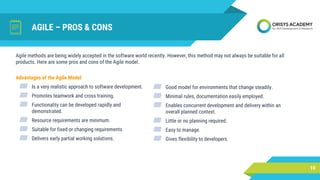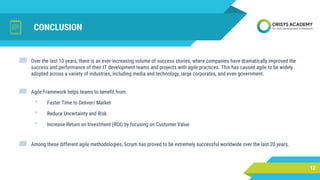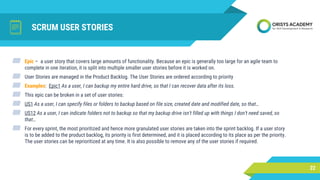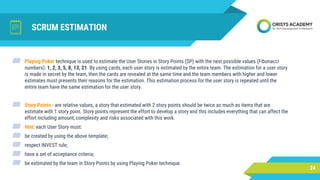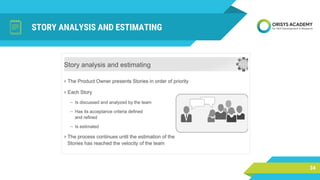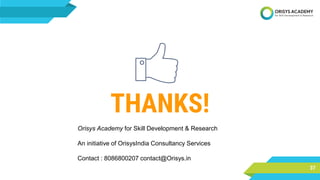Agile & SCRUM basics
- 2. AGENDA ▰ SCRUM ROLES ▰ SCRUM EVENTS ▰ SCRUM ARTIFACTS ▰ SCRUM USER STORIES ▰ ESTIMATION ▰ BURNDOWN CHART ▰ SCRUM TOOLS ▰ FAQS 2 ▰ INTRODUCTION ▰ AGILE MANIFESTO ▰ AGILE CHARACTERISTCIS ▰ AGILE FRAMEWORK ▰ AGILE PROS & CONS ▰ SCRUM OVERVIEW ▰ SCRUM FRAMEWORK ▰ SPRINT
- 3. INTRODUCTION ITERATIVE INGREMENTAL MODEL In the iterative incremental model, the development starts with a limited number of finalized and prioritized requirements. The deliverable is a working increment of the product. A set of activities ranging from requirements to code development is called an iteration. Based on the functionality of the increment and any or all of the new, modified, pending requirements, the next lot of requirements is given to the subsequent iteration. The outcome of the subsequent iteration is an enhanced working increment of the product 3 WATERFALL MODEL The most commonly used software development model with this characteristic is the Waterfall Model as depicted in the following diagram. However, in most of the cases, new functionalities get added, and also earlier requirements may change. The Waterfall model is not structured to accommodate such continuous changes in requirements. Further, the user will not have clarity on the functionality of the product till the product becomes available in its entirety.
- 4. INTRODUCTION Agile is a software development methodology based on iterative incremental development to build a software incrementally using short iterations of 1 to 4 weeks so that the development process is aligned with the changing business needs. It recommends a time-boxed iterative approach, and encourages rapid and flexible response to change 4
- 6. AGILE MANIFESTO PRINCIPLES 6 1. Our highest priority is to satisfy the customer through early and continuous delivery of valuable software. 2. Welcome changing requirements, even late in development. Agile processes harness change for the customer's competitive advantage. 3. Deliver working software frequently, from a couple of weeks to a couple of months, with a preference to the shorter timescale. 4. Business people and developers must work together daily throughout the project. 5. Build projects around motivated individuals. Give them the environment and support they need, and trust them to get the job done. 6. The most efficient and effective method of conveying information to and within a development team is face-to-face conversation.
- 7. AGILE MANIFESTO PRINCIPLES 7 7. Working software is the primary measure of progress. 8. Agile processes promote sustainable development. The sponsors, developers, and users should be able to maintain a constant pace indefinitely. 9. Continuous attention to technical excellence and good design enhances agility. 10. Simplicity--the art of maximizing the amount of work not done--is essential. 11. The best architectures, requirements, and designs emerge from self-organizing teams. 12. At regular intervals, the team reflects on how to become more effective, then tunes and adjusts its behavior accordingly.
- 8. AGILE CHARACTERISTICS FACE TO FACE COMMUNCIATION Each agile team should have a customer representative such as a product owner in scrum methodology. This representative is authorized to act on behalf of the stakeholders and he can answer the queries of the developers in between iterations. An information radiator (physical display) is normally located prominently in an office, where passers-by can see the progress of the agile team. This information radiator shows an up-to-date summary of the status of a project. 8 ITERATIVE / INCREMENTAL & READY TO EVOLVE Most of the agile development methods break a problem into smaller tasks. There is no direct long-term planning for any requirement. Normally, iterations are planned which are of vary short period of time, for example, 1 to 4 weeks. A cross-functional team is created for each iteration that works in all functions of software development like planning, requirements analysis, design, coding, unit testing, and acceptance testing. The result at the end of the iteration is a working product and it is demonstrated to the stakeholders at the end of an iteration. After demo, review comments are taken and are planned to be incorporated in the working software as required. FEEDBACK LOOP Daily stand-up is a common culture of any agile development; it is also known as daily scrum. It is a kind of a brief session where each team member reports to each other regarding the status of what they have done, what to do next, and any issues they are facing.
- 10. AGILE – PROS & CONS Advantages of the Agile Model ▰ Is a very realistic approach to software development. ▰ Promotes teamwork and cross training. ▰ Functionality can be developed rapidly and demonstrated. ▰ Resource requirements are minimum. ▰ Suitable for fixed or changing requirements ▰ Delivers early partial working solutions. 10 Agile methods are being widely accepted in the software world recently. However, this method may not always be suitable for all products. Here are some pros and cons of the Agile model. ▰ Good model for environments that change steadily. ▰ Minimal rules, documentation easily employed. ▰ Enables concurrent development and delivery within an overall planned context. ▰ Little or no planning required. ▰ Easy to manage. ▰ Gives flexibility to developers.
- 11. AGILE – PROS & CONS Disadvantages of the Agile Model are as follows ▰ Not suitable for handling complex dependencies. ▰ More risk of sustainability, maintainability and extensibility. ▰ An overall plan, an agile leader and agile PM practice is a must without which it will not work. ▰ Strict delivery management dictates the scope, functionality to be delivered, and adjustments to meet the deadlines. 11 Agile methods are being widely accepted in the software world recently. However, this method may not always be suitable for all products. Here are some pros and cons of the Agile model. ▰ Depends heavily on customer interaction, so if customer is not clear, team can be driven in the wrong direction. ▰ There is a very high individual dependency, since there is minimum documentation generated. ▰ Transfer of technology to new team members may be quite challenging due to lack of documentation.
- 12. CONCLUSION ▰ Over the last 10 years, there is an ever-increasing volume of success stories, where companies have dramatically improved the success and performance of their IT development teams and projects with agile practices. This has caused agile to be widely adopted across a variety of industries, including media and technology, large corporates, and even government. ▰ Agile Framework helps teams to benefit from: • Faster Time to Deliver/ Market • Reduce Uncertainty and Risk • Increase Return on Investment (ROI) by focusing on Customer Value ▰ Among these different agile methodologies, Scrum has proved to be extremely successful worldwide over the last 20 years. 12
- 13. SCRUM OVERVIEW ▰ Scrum is a framework for developing and sustaining complex products. Ken Schwaber and Jeff Sutherland developed Scrum ▰ Scrum is a framework within which people can address complex adaptive problems, while productively and creatively delivering products of the highest possible value. ▰ Scrum is an agile process ▰ Business/Customer sets the priority ▰ Teams self organize to determine the best way to deliver the highest priority features ▰ Scalable to distributed , large and long projects ▰ Scrum is a specific agile process framework that defines the practices required to be followed. 13
- 15. SPRINT ▰ The Scrum is an iterative methodology, and the Scrum name for iteration is "Sprint". ▰ Iterations are single development cycle where each agile teams defines, builds, integrates and test the user stories from their iteration backlog ▰ Each iteration is of same length running back to back ▰ The goal is to deliver working software at the end of each iteration 15
- 16. SPRINT ▰ In the diagram below you can see a Scrum project development split into 24 iterations for a full year duration. ▰ Sprint 0 – is the special iteration performed at the beginning of a project and forms the framework upon which each subsequent iteration builds. The duration of this iteration will vary depending on the complexity and existing knowledge of the desired capability. During this special Sprint perform enough architecture and system design in order to start development and get the first Sprint started. (Additional architecture and system engineering will be performed as necessary during subsequent iterations). ▰ After Sprint 0 all other Sprints must have the same length. This length could be between 1 and 4 weeks. The recommended length is 2 weeks. ▰ At the beginning of the Sprint, the team have a clear commitment on the scope, and the scope for current Sprint cannot be changed during the Sprint. ▰ Short iterations enable Product Owners to get client feedback faster, developer estimates faster, and faster updates to plans, thereby shortening the whole feedback cycle. Any project should have at least three such occasions for stakeholders to provide their feedback before the release. 16
- 17. SCRUM ROLES PRODUCT OWNER ▰ Define the features of the product. ▰ Decide on release date and content. ▰ Be responsible for the profitability of the product (ROI). ▰ Prioritize features according to market value. ▰ Adjust features and priority every iteration, as needed ▰ Accept or reject work results. 17 SCRUM MASTER ▰ Ensure that the team is fully functional and productive ▰ Enable close cooperation across all roles and functions ▰ Remove barriers ▰ Shield the team from external interferences during the Sprint ▰ Ensure that the process is followed, including issuing invitations to Daily Scrum, Sprint Review and Sprint Planning meetings ▰ Has the right to do everything within the boundaries of the project guidelines to reach the Sprint goal ▰ Organizes itself and its work ▰ Demos work results to the Product Owner TEAM ▰ Seven (plus/minus two) members ▰ Is cross-functional (Skills in testing, coding, architecture etc.) ▰ Selects the Sprint goal and specifies work results
- 18. SCRUM EVENTS BACKLOG GROOMING Backlog refinement meeting in order to ensure that the backlog remains populated with items that are relevant, detailed and estimated according with their priorities, and in keeping with current understanding the product and its objectives. The duration of this meeting should not be longer then 2 hours. Could have a Backlog Grooming each week and must have a Backlog Grooming before to start next Sprint! 18 SPRINT PLANNING Is a time-boxed to a maximum of 8 hours for a 4 weeks Sprint. The new sprint starts with this meeting. A set of user stories from the top of the Product Backlog are estimated into story points then decomposed into tasks and estimated in hours. Finally the Team, based on the Team Capacity, selects a set of these stories into the new Sprint Backlog (that may contains also unfinished user stories from the previous Sprint). DAILY SCRUM MEETING ▰ Daily stand up meeting of the entire team including Product Owner no longer then 15 minutes. Each participant should answer to the next 3 questions: ▰ What did I do yesterday that helped the Team meet the Sprint Goal? ▰ What will I do today to help the Team meet the Sprint Goal? ▰ Do I see any impediment that prevents me or the Team from meeting the Sprint Goal?
- 19. SCRUM EVENTS 19 SPRINT REVIEW ▰ At the end of each Sprint a Review/Demo meeting is held. During this meeting the Team shows what they accomplished during the Sprint. Typically this takes the form of a demo of the new features or underlying architecture. The stakeholders will provide the feedback. The duration of this meeting should be maximum 2 hours. ▰ Did we meet the sprint Goal ▰ Story by story review SPRINT RETOSPECTIVE ▰ Meeting that helps the team to fine-tune the process. This is a time for each team member to reflect on what went right and areas for improvement. Clear action items should be defined. The duration of this meeting should be maximum 2 hours. ▰ Did the team meet the goal? ▰ Collect & review the agreed to iteration metrics ▰ What went well ? ▰ What didn’t? ▰ What we can do better next time ? What can we preserve?
- 20. SCRUM ARTIFACTS 20 ▰ Product Backlog – is an always changing, dynamically prioritized list of requirements ordered by Business Value. Requirements are broken down into User Stories by the Product Owner. Definition of Done (DoD) at the Backlog level. ▰ Sprint Backlog - contains all committed User Stories for the current Sprint broken down into Tasks by the Team. All items on the Sprint Backlog should be developed, tested, documented and integrated to fulfill the Team commitment. ▰ Burndown Chart - shows the amount of work remaining per Sprint. It shows the correlation between work remaining at any point in time and the progress of the Team.
- 21. SCRUM USER STORIES User Story (shortly US) - is a short, simple description of a feature told from the perspective of the person who desires the new capability, usually a user or customer of the system. 21 Acceptance criteria - Each User Story also has Acceptance Criterion defined, so that correctness of implementation of the user story is confirmed by passing the Acceptance Test that is based on the Acceptance Criteria ▰ INVEST helps to remember a widely accepted set of criteria, or checklist, to assess the quality of a user story. ▰ I (Independent) ; N (Negotiable) ;V (Valuable) ;E (Estimable) ;S (Small) ;T (Testable) ▰ User story structure : As a <user role>, I want <activity > so that <Business value> • User Role – Description of person, device or system doing action • Activity – is what they can do with the system • Business Value –is why they want to do the activity
- 22. SCRUM USER STORIES 22 ▰ Epic – a user story that covers large amounts of functionality. Because an epic is generally too large for an agile team to complete in one iteration, it is split into multiple smaller user stories before it is worked on. ▰ User Stories are managed in the Product Backlog. The User Stories are ordered according to priority ▰ Examples: Epic1 As a user, I can backup my entire hard drive, so that I can recover data after its loss. ▰ This epic can be broken in a set of user stories: ▰ US1 As a user, I can specify files or folders to backup based on file size, created date and modified date, so that… ▰ US12 As a user, I can indicate folders not to backup so that my backup drive isn't filled up with things I don't need saved, so that… ▰ For every sprint, the most prioritized and hence more granulated user stories are taken into the sprint backlog. If a user story is to be added to the product backlog, its priority is first determined, and it is placed according to its place as per the priority. The user stories can be reprioritized at any time. It is also possible to remove any of the user stories if required.
- 23. SCRUM ESTIMATION 23 ▰ In Scrum Projects, Estimation is done by the entire team during Sprint Planning Meeting. The objective of the Estimation would be to consider the User Stories for the Sprint by Priority and by the Ability of the team to deliver during the Time Box of the Sprint. ▰ Product Owner ensures that the prioritized User Stories are clear, can be subjected to estimation, and they are brought to the beginning of the Product Backlog. The size of the Product Increment is estimated in terms of User Story Points ▰ There are several types of scales that are used in Scrum Estimation. Following are some examples: ▰ Numeric Sizing (1 through 10) ▰ T-shirt Sizes (XS, S, M, L, XL XXL, XXXL) ▰ Fibonacci Sequence (1, 2, 3, 5, 8, 13, 21, 34, etc.) ▰ Dog Breeds (Chihuahua,………,Great Dane)
- 24. SCRUM ESTIMATION 24 ▰ Playing Poker technique is used to estimate the User Stories in Story Points (SP) with the next possible values (Fibonacci numbers): 1, 2, 3, 5, 8, 13, 21. By using cards, each user story is estimated by the entire team. The estimation for a user story is made in secret by the team, then the cards are revealed at the same time and the team members with higher and lower estimates must presents their reasons for the estimation. This estimation process for the user story is repeated until the entire team have the same estimation for the user story. ▰ Story Points - are relative values, a story that estimated with 2 story points should be twice as much as items that are estimate with 1 story point. Story points represent the effort to develop a story and this includes everything that can affect the effort including amount, complexity and risks associated with this work. ▰ Hint: each User Story must: ▰ be created by using the above template; ▰ respect INVEST rule; ▰ have a set of acceptance criteria; ▰ be estimated by the team in Story Points by using Playing Poker technique.
- 25. BURNDOWN CHARTS 25 ▰ Burndown Chart - shows the amount of work remaining per Sprint. It shows the correlation between work remaining at any point in time and the progress of the Team. ▰ Burndown Chart is normally generated by a SW tool, is used by the Scrum Master in order to track each Sprint and is useful for predicting when the work for the current Sprint will be completed. ▰ Sprint Velocity - Number of Story Points completed per Sprint.
- 26. SCRUM TOOLS 26 Scrum Tools facilitate planning and tracking for Scrum projects. They provide a single place for managing the product backlog, sprint backlog, planning and tracking Sprints, displaying Burndown charts, conducting daily Scrum Meetings, and conducting Scrum Retrospectives. Some available scrum tools in Market • Jira • Mingle • Daily Scrum • Scrum Factory ▰ Agile in general, Scrum in specific does not mean there is no documentation work. The Scrum Artifacts are defined, Scrum Planning and Tracking are well established. ▰ Scrum Tools facilitate in capturing and tracking information regarding the Scrum Projects. The choice of the tool depends on the features required by the organization, in addition to the needs for any other tool.
- 27. DEVOPS 27 ▰ DevOps is a culture which promotes collaboration between Development and Operations Team to deploy code to production faster in an automated & repeatable way. The word 'DevOps' is a combination of two words 'development' and 'operations.' ▰ DevOps helps to increases an organization's speed to deliver applications and services. It allows organizations to serve their customers better and compete more strongly in the market. ▰ In simple words, DevOps can be defined as an alignment of development and IT operations with better communication and collaboration.
- 28. DEVOPS 28
- 29. CONCLUSION 29 ▰ The main benefits of using Scrum in software development are ▰ Increased product quality ▰ Enhanced transparency ▰ Increased flexibility ▰ Reduced risks ▰ Maximized productivity ▰ Improved communication ▰ Maximized cooperation ▰ Agile and Scrum are not the same. Scrum is one of the process frameworks adapting Agile. Scrum is advised to teams with experienced team members as the Framework requires great collaboration and self-organization as well. If the Scrum rules are not followed strictly, a project can lead to failure. Hence, it is necessary to have a proper understanding of Scrum concepts among the entire team.
- 30. Q&A 30
- 31. APPENDIX 31
- 34. STORY ANALYSIS AND ESTIMATING 34
- 36. USING THE TEAM BOARD TO TRACK PROGRESS 36
- 37. 37 THANKS! Orisys Academy for Skill Development & Research An initiative of OrisysIndia Consultancy Services Contact : 8086800207 contact@Orisys.in










